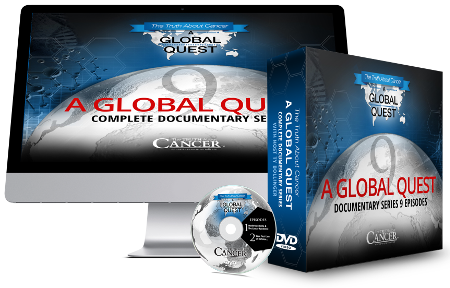Greg,

Further to my e-mail yesterday, as expected,
Chanel 7 National network current affairs show ran a story last night on Herb Veil 8.
[The natural escharotic we created in the early 90's with Lenex Labs, as discussed in
Chapter 3 of Meditopia]
Of course, it was only doctors and dermatologist being interviewed. And the usual
threats of doom and gloom and death.

They made comments about root systems
not being removed causing metastasis. Big fear campaign.

The dermatologist said that this should be banned.
It comes into Australia under the guise of a simple herbal preparation. It should be
subject to the usual drug testing and registering. Who is going to pay that sort
of money to register a product that can't be patented. Certainly not the drug companies.
We are talking in the vicinity of $200,00 AUD. and then there no guarentees that they will
pass it, and we know they probably wouldn't. In Australia, the TGA is self funded, so the
only money they get is from application fees from drug companies submitting drugs
for registration. Slight conflict of interest.

This rubbish is the most frustrating part of what we do.
 Have you heard of a product called 'Curaderm'?
Have you heard of a product called 'Curaderm'?
It is a cream that is available from chemists(drug stores) for use on skin cancers.
This one
is legal as such, and I have seen horrendous scars from the burns this cream causes.
It is non-selective to neo-plastic or healthy tissue. Can you beleive the hippocracy.

Any way, I'll get off my soap box now.
I'll keep you up with anything else that happens.

Regards

[ Name withheld for lack of specific permission ]

Australia / Friday, March 19, 1999

This was not the first time I had heard of Curaderm®,
but this correspondence -- to the best of my knowledge and memory -- is the first time that
a customer alluded to the extensive damage that this product could cause or that, unlike
Cansema® and other properly prepared escharotics, it was non-specific. In other words,
with sufficient "residence time," it burns a hole wherever you apply it. Quite predictably, this simple email would
take us on a journey of countless emails and phone calls of desperate people, begging for help
as a result of the damage that Curaderm® had wrought . . . which continues to the
present day.

There is a reason for this: Curaderm's destructive properties
are by design.

In what is arguably the most demanding philosophical
work of the twentieth century, Ludwig Wittgenstein informs us, "In logic, nothing is accidental:
If a thing can occur in a state of affairs, the possibility of the state of affairs must be
written into the thing itself." (1) Curaderm's horrific effects, which we will discuss in a moment,
come from its design as Coramsine,
an
experimental cancer drug. Its creator, Dr. Bill Cham, attempts to tether Curaderm's fortunes to
Mother Nature in his book,
The Eggplant
Cancer Cure: A Treatment for Skin Cancer and New Hope for Other Cancers from Nature's Pharmacy,
but Curaderm has nothing to do with "nature's pharmacy," its discovery having originated from
a prominent nightshade member, notwithstanding. You can't extract, isolate, and refine something
that comes from wholeness and still say that wholeness has been preserved. Or as I wrote 11 years
ago (2004) in
Premise #4 of
Meditopia: "Cleaving Wholeness for Fragmentationalism was the first step in the development
of modern medicine." Perhaps another "real life" example will help to understand this point:

In
Chapter 1 of
Meditopia, I introduce the reader to my mentor in the area of escharotics,
the late Dr. Russell Jordan, the founder of not one, but two,
successful pharmaceutical companies. He co-founded a company called Vipont Pharmaceutical that made
a phenomenal dentifrice called Viadent® that, for years, sold very successfully in drug stores
all over the U.S. I say "phenomenal" because this dentifrice cleaned the teeth better and more
thoroughly than competing brands of toothpaste, while eliminating gingivitis and inhibiting periodontal
disease. (Our own
AO Herbal Toothpaste owes its own
remarkable properties to the early work that was done at Vipont).
So what becomes of this success story? Colgate Palmolive buys the company for $88 million,
further refines the bloodroot (Sanginaria canadensis) in the product to just one of its medicinal
alkaloids (sanguinarene), in the manner of Curaderm, and the product stops working as it did. Consumers stop buying the product.
Colgate takes the product off the market. End of story.

As long-time practicing herbalists, we understand that
when you're dealing with "plant medicines," you're working with a symphony of phytopharmacological
components that work together. If you pull a first violinist from a symphony orchestra and ask
her to play a Mozart Concerto, do you still get anything close to the same sound as you get
with the full orchestra? Of course not.

Supporting my contention that Curaderm® has its
place in tne "secondary effects" constellation of harmful pharmaceutical drugs is its
positively glowing article in Wikipedia.
As Mike Adams (
Natural News) has stated on
numerous occasions, if you want pro-Big Pharma propaganda and disinformation,
you go to Wikipedia.

With this in mind, let's review some of the
results of Curaderm :
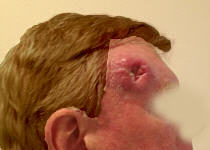
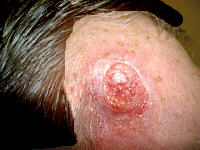
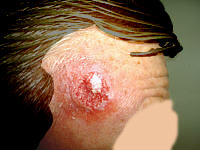
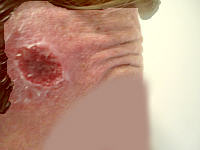
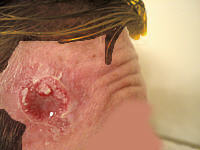
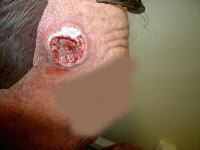
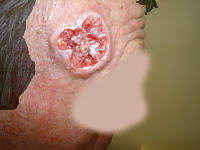
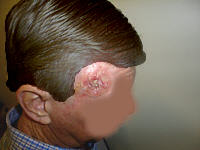
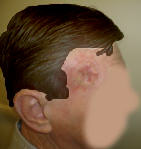
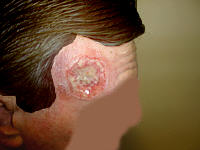
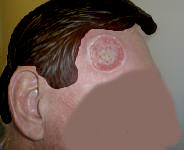
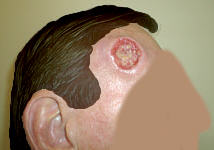
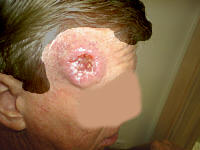
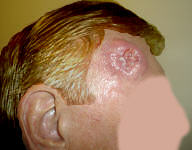

In the summer of 2013, I began receiving
letters and emails from the daughter of a Curaderm customer who had been applying the product
twice a day for twelve continuous months, as instructed by the manufacturer -- (roughly
April, 2012 through April, 2013).
This involved the treatment of a small SCC (squamous cell carcinoma),
something that Cansema® is used to successfully treat everyday.
As the months passed and the resulting burn got
worse and worse, the customer was advised to continue to apply the product,
despite a complete lack of evidence that the product was working and
an abundance of evidence that the burn was getting worse.

It should be noted that except for larger growths
(say, 5 cm. or 2 inches), the ENTIRE process, from start to finish, with a well-made
escharotic is
in the neighborhood of 40 days and involves
a handful or applications of the Salve.

This is something you see with Curaderm®
that you will not see with any properly made escharotic that is applied according
to good instructions: a burn so bad and so deep, that it is too painful to apply
or spray analgesics or other functional topicals. Strangely, these are burns that
do not heal. Neither with medical assistance or the passage of time.

On July 15, 2015 -- more than two years
later -- I received this brief email from the same email address:
"A couple years ago showed husband's squamous skin on parietal area.
Used Curaderm. He is nearing the end, it went to the parotid and now brain.
I just can't believe it. . . . [Phone number follows.] "

I am following up to get the
latest information on this case.
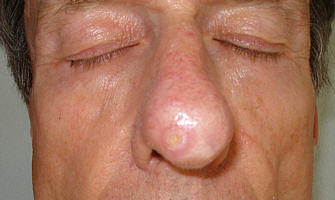
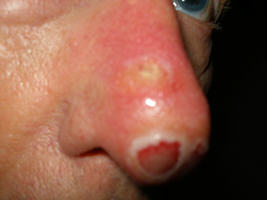

On July 11, 2013 I received an email
that reads as follows:
"Attached is a photo of the current lesion on my nose
after 167 days of treatment with Curaderm. [Our emphasis added.]
I am also attaching a picture taken in January 2013, it is #1;
and the current one is P1010001. I do not know if the photo is clear enough for you to
view but I would appreciate your assessment of what you see."

This example further illustrates the extent
to which Curaderm® -- despite the "cure" in its name -- is not designed to
treat anything. It's a pharmaceutical. It fits the pharmaceutical model:
it is designed to endlessly TREAT an area, not completely cure it.
The second picture follows 167 days of daily treatments. How many people
would use the product, if -- upfront -- they knew that after five and a half
months, their problem was worse?

The reality of this sinks in when you
read email like the following, which Cathryn received on February 9, 2010:
"Before I used Cansema®, the area . . . was previously treated with
Curaderm® for about a year and then Aldera
which didn't do anything . . . I am just anxious to finish with this as I have
been dealing with it since 2006."

Four years later, and this woman, or anyone,
for that matter, is still treating a basal cell carcinoma?
Is that really possible? Of course, it is. This is the idea of pharmaceutical
medicine: continue to treat the patient, month and month, year after year.
Curaderm does this because -- going back to Wittgenstein -- it has
"been written into the thing itself."

Since not just Ty Bollinger,
but everyone else who is paid, directly or indirectly, to act as a cheerleader
for pharmaceutical companies, large or small, fosters the idea, whether
they realize it, that they are diminishing the expectations of what
is possible in health care, a reading of the following letter
helps illustrate this tragedy.

It is dated February 6, 2010 -- and, again, except for bracketed
"Editor" notes in two places, it remains unaltered :
 Dear Cathryn,
Dear Cathryn,
 (I saw your response on the Topical Info. Forum. Good for you!)
(I saw your response on the Topical Info. Forum. Good for you!)
 Thank you. I am very grateful that I'm able to buy this from you.
I'm not sure when I will be using it because I do have some concerns, which I will try to briefly explain
to you in hopes that you can give me your experienced feedback.
Thank you. I am very grateful that I'm able to buy this from you.
I'm not sure when I will be using it because I do have some concerns, which I will try to briefly explain
to you in hopes that you can give me your experienced feedback.
 First! Failed Mohs surgery for BCC on face.
First! Failed Mohs surgery for BCC on face.
 My (ex) doctor did not see its return, which enabled it to "burrow in"
and send out tentacles all across my left cheek.
My (ex) doctor did not see its return, which enabled it to "burrow in"
and send out tentacles all across my left cheek.
 I went to many doctors looking for support in using a topical salve.
They were all rude, arrogant and treated me like I'm stupid.
I went to many doctors looking for support in using a topical salve.
They were all rude, arrogant and treated me like I'm stupid.
 So, I started using (on my own) Curaderm a year and a half ago.
The site quickly became a crater (about the size of a pencil eraser), and for over a year black stuff came
out of that crater. The Curaderm was very beautifully pulling out the tentacles. (I could see the black
right under the surface of my skin). (No more). It's been months since there's been any black stuff coming out.
Now there's a little bit of white stuff being pulled out.
So, I started using (on my own) Curaderm a year and a half ago.
The site quickly became a crater (about the size of a pencil eraser), and for over a year black stuff came
out of that crater. The Curaderm was very beautifully pulling out the tentacles. (I could see the black
right under the surface of my skin). (No more). It's been months since there's been any black stuff coming out.
Now there's a little bit of white stuff being pulled out.
 Meanwhile, the "core" of the BCC is still very visible in the bottom
of the (shallow) crater. The Curaderm keeps killing it (yucky yellow stuff coming out every day) but after
all this time it's still there. (And keeps looking about the same. I would think the crater would get deeper and
deeper as the cancer died?). I want to GET IT OUT OF THERE! I know that Cansema will do it (I ordered it
with aloe, since the cancer is on my face plus I'm so tired of the extreme pain after 1 1/2 years), but I'm
concerned about the small amount of white stuff that is still being pulled out from just under the skin's surface.
Would the Cansema get the core, close up, and leave more that needs to be pulled out from the outlying area?
Or might the whole cheek, wherever there is what's being pulled out, turn into one huge reaction?
[Editor's: She is posing this question because this is what you can expect from Curaderm, with which
she is familiar.]
Meanwhile, the "core" of the BCC is still very visible in the bottom
of the (shallow) crater. The Curaderm keeps killing it (yucky yellow stuff coming out every day) but after
all this time it's still there. (And keeps looking about the same. I would think the crater would get deeper and
deeper as the cancer died?). I want to GET IT OUT OF THERE! I know that Cansema will do it (I ordered it
with aloe, since the cancer is on my face plus I'm so tired of the extreme pain after 1 1/2 years), but I'm
concerned about the small amount of white stuff that is still being pulled out from just under the skin's surface.
Would the Cansema get the core, close up, and leave more that needs to be pulled out from the outlying area?
Or might the whole cheek, wherever there is what's being pulled out, turn into one huge reaction?
[Editor's: She is posing this question because this is what you can expect from Curaderm, with which
she is familiar.]
 My other concern is that I do have more, superficial, BCCs nearby.
Curaderm recommends treating one at a time, so I've been waiting to treat the others. I was hoping to treat
the one larger superficial BCC with Curaderm because the scarring is supposed to be the least of all topical salves.
I've read in your testimonials that some people have other, previously unknown cancers pop out elsewhere from
the main treatment site. I know that sounds great, but the scarring might end up being worse. (At least with the large one).
[Editor's: Once again, the question arises because of expectations created from the use of Curaderm.]
My other concern is that I do have more, superficial, BCCs nearby.
Curaderm recommends treating one at a time, so I've been waiting to treat the others. I was hoping to treat
the one larger superficial BCC with Curaderm because the scarring is supposed to be the least of all topical salves.
I've read in your testimonials that some people have other, previously unknown cancers pop out elsewhere from
the main treatment site. I know that sounds great, but the scarring might end up being worse. (At least with the large one).
[Editor's: Once again, the question arises because of expectations created from the use of Curaderm.]
 Plus, I have a lot of "pre-cancer"? on the surface on my cheek.
That's scary. How might the Cansema affect that?
Plus, I have a lot of "pre-cancer"? on the surface on my cheek.
That's scary. How might the Cansema affect that?
 Many, many thanks for your consideration of my case.
I hope I explained it clearly enough.
Many, many thanks for your consideration of my case.
I hope I explained it clearly enough.
 It's been a long, scary, lonely journey.
It's been a long, scary, lonely journey.
"Stephanie"

. . . this need to correct the disfiguring effects of Curaderm is a regular
theme in the emails we get. This one came to Cathryn on March 10, 2010:
Sorry about incomplete previous e-mail just sent. I need help to know what to order,
and I would like to order today. I have a large cancer, probably a BCC, on scalp and below
hairline behind ear and is getting larger. It oozes and will sometimes bleed different areas
as I try to remove some of the dried discharge. I used "Curaderm" two years ago twice a day
for four months and it seemed to do the job, but when I discontinued using it a raised elongated
area appeared below original sore and now almost touches my ear. Please help, I am really getting
nervous about this and will order whatever is needed. I prefer to not go the surgery route, the end
result will probably look worse.
"Jan"

Similar is this email, received on February 9, 2009:
Hello. I had a squamous cell carcinoma on my chest 18 months ago and used Curaderm.
I had what looked like a precancerous lesion on my face a few months ago and successfully treated
it with numerous applications of oregano oil. Now I have a new one on my face that looks a bit
like the one on my chest, and have tried the oregano oil for several days without success.
I am hesitant to use Curaderm on my face because it left a large scare on my chest, whereas
the oregano oil treatment left no scare. It scabbed up quite a bit, but left no visible scar.
Do you have practitioners in the U.S. who use your product that I might consult with to help me,
and hopefully help minimize any scarring? Any help would be greatly appreciated.
Mrs. S.E.

. . . or this letter, dated September 2, 2009:
I read the Cathryn's post on a cancer web site and was so impressed with her honesty . . .
I have been treating a squamous cancer in my ear with Curaderm. It has increased from a pea size
to 16x16 mm and still does not seem to be healing. Do you recommend any of your topical applications
to this situation? I have used the Curaderm for a month.

The vast majority of the letters and phone calls we have
gotten concerning Curaderm do not even specify what the nature of their problem is with it.
Such complaints remain non-specific, as if the end user is embarrassed to share the details.
This email dates to January 25, 2002:
I have a cancerous lesion one inch in diaminter on the side of my nose and face.
I would like to use your product Cansema to remove the cancer. I would like to know if there
is someone in my area I could speak with about this product. I have Basal Cell (Carcinoma)
and have tried a product called Curaderm without success.
Mr. C.F.T.
San Diego, Ca.
 Conclusion:
Conclusion: We can only speak to our experience
of Curaderm® from what our customers or even strangers have told us. No one at Alpha Omega Labs
has ever used Curaderm®, as we would never have a need to do so.

But what haunts us is that someone as prominent in the
alternative health care field as Ty Bollinger is singing the praises of a pharmaceutical that
is vastly inferior to natural remedies.

Let us hope that this was merely an anomalous error in the
work of an otherwise admirable documentarian.

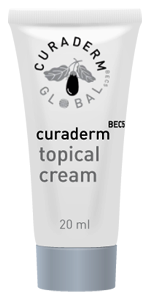 Curaderm: A Naturopathic Assessment
Curaderm: A Naturopathic Assessment
